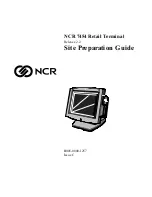
- 28 -
IDE Primary Master / Slave:
IDE Secondary Master / Slave:
The BIOS can automatically detect the specifications and optimal operating mode of
almost all IDE hard drives. When you select type AUTO for a hard drive, the BIOS detect
its specifications during POST, every time system boots.
If you do not want to select drive type AUTO, other methods of selecting drive type are
available:
1. Match the specifications of your installed IDE hard drive(s) with the
preprogrammed values for hard drive types 1 through 45.
2. Select USER and enter values into each drive parameter field.
3. Use the IDE HDD AUTO DETECTION function in Setup.
Here is a brief explanation of drive specifications:
Type: The BIOS contains a table of pre-defined drive types. Each defined drive type
has a specified number of cylinders, number of heads, write precompensation factor,
landing zone, and number of sectors. Drives whose specifications do not
accommodate any predefine type are classified as type USER.
• Size: Disk drive capacity (approximate). Note that this size is usually greater
than the size of a formatted disk given by a disk-checking program.
• Cyls: number of cylinders.
• Head: number of heads.
• Precomp: write precompensation cylinders.
• Landz: landing zone.
• Sector: number of sectors.
• Mode: Auto, Normal, Large or LBA.
Auto: The BIOS automatically determines the optimal mode.
• Normal: Maximum number of cylinders, heads, sectors supported are 1024, 16
and 63.
• Large: For drives that do not support LBA and have more than 1024 cylinders.
• LBA (Logical Block Addressing): During drive accesses, the IDE controller
transforms the data address described by sector, head and cylinder number
into a physical block address, significantly improving data transfer rates. For
drives greater than 1024 cylinders.
Содержание QT-8000
Страница 10: ...8 2 DISASSEMBLY STEP 1 Remove HDD Cover STEP 2 Remove HDD Pull out the HDD cable Release the 4 screws...
Страница 11: ...9 STEP 3 Remove Card Reader Cover STEP 4 Remove Back Cover Release the 3 screws Release the 15 screws...
Страница 12: ...10 STEP 5 Remove Chassis_T STEP 6 Remove CF Board MSR Board Release the 6 screws Release the 5 screws...
Страница 14: ...12 STEP 9 Remove Main Board STEP 10 Main Board Release the 5 copper pillars Release the 4 screws...
Страница 15: ...13 STEP 11 Remove Inverter Board STEP 12 Inverter Board Release the 2 screws...
Страница 16: ...14 STEP 13 Remove the Control Board of Touch Panel STEP 14 Control Board of Touch Panel Release the 2 screws...
Страница 17: ...15 STEP 15 Remove Base STEP 16 Remove LCD Panel Remove 14 screws Remove 4 screws from both side of system base...
Страница 18: ...16 STEP 17 Remove Touch Panel Remove Touch Panel...
Страница 20: ...18 5 6 7 8 9 10...
Страница 57: ...55 7 2 Block diagram 1 System Connection Diagram...
Страница 58: ...56 2 System block diagram...
Страница 62: ...60 5V 4 6 12V 2 4 RI 17 18 5V 7 9 COM3 12V 9 11 RI 19 20 5V 8 10 COM4 12V 10 12...
















































